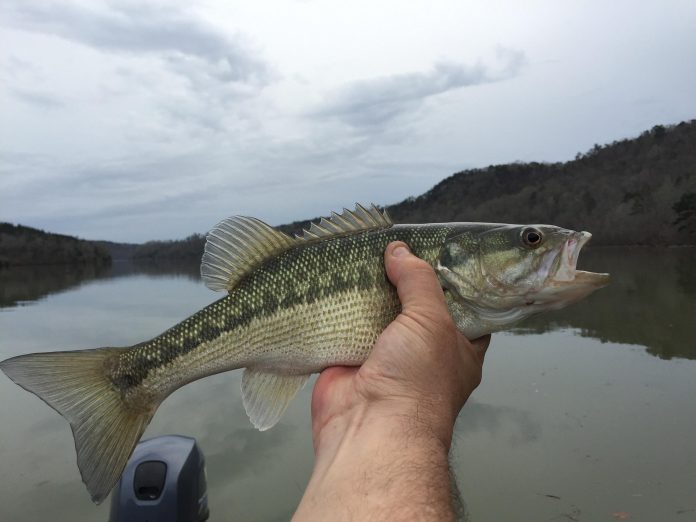Summer bass fishing offers dramatically different experiences across regions, with northeast Ohio’s cooler waters providing world-class smallmouth action while Florida’s Sarasota area delivers year-round largemouth opportunities in a subtropical setting.
Bass fishing catch rates are generally higher during summer months, making June through August prime time for anglers targeting these popular gamefish. However, tactics, target species and fishing conditions vary significantly between northern and southern destinations.
Northeast Ohio Sets National Standards
Lake Erie dominates northeast Ohio’s bass scene, offering world-class smallmouth bass fishing with the western basin warming to 75-80 degrees in mid-summer. Smallmouth bass live in areas 20-40 feet deep around underwater structures, ledges and rocks, with drift fishing using live minnows proving most effective.
During summer heat, bass continue feeding on Lake Erie’s abundant emerald shiners, with unweighted finesse worms cast to shallow flats enticing inactive smallies. The bass bite typically peaks between 20 and 40 feet of water during late June through August, requiring vertical approaches using jigging spoons, blade baits and tube jigs.
Summit County’s Portage Lakes system near Akron consistently produces 17- to 25-pound tournament bags despite heavy fishing pressure. This chain of nine interconnected lakes spans 1,190 acres with 46 miles of shoreline where largemouth bass hide in thick summer weed beds, making floating frogs effective in morning hours.
Lakes with electric motor restrictions like Mogadore and LaDue produce average bass around 3 pounds along with numerous 8- to 9-pounders. These waters limit boats to electric trolling motors only, reducing noise and disturbance that helps maintain quality fishing. Mosquito Creek Reservoir ranks as northeast Ohio’s second-best producer, requiring upper teen weights to win summer tournaments on its 7,000 acres.
Transitional Waters Offer Variety
Moving south through Ohio, Clear Fork Reservoir and Lake Milton provide distinct fishing experiences with varied structure including points, drop-offs and vegetation. These northeastern Ohio waters feature both largemouth and smallmouth populations, with largemouth responding to spinnerbaits, jigs and plastic worms around weed beds and fallen timber.
The Ohio River system offers excellent summer opportunities for both largemouth and smallmouth bass, with largemouth moving to deeper backwaters and responding to jigging spoons fished in creek mouths during peak summer heat.
Sarasota Area Provides Subtropical Action
The Sarasota region offers year-round bass fishing opportunities with action staying relatively steady through summer months despite Florida’s heat. The period between May and August proves ideal for targeting bass, with multiple freshwater options within short driving distances.
Lake Tarpon, located just north of Tampa in Pinellas County, stands as the crown jewel for bass fishing near Sarasota. This 2,500-acre lake earned its reputation by holding the Florida state record for largemouth bass at 19.6 pounds, caught using live shiners.
During summer months on Tarpon, bass move further offshore to vegetation outcroppings sprouting from humps and ledges where abundant shad await. Morning fishing finds bass closest to shoreline areas with cattails and bulrush, while afternoon offshore debris holds the largest specimens.
Lake Manatee, Evers Lake and upper Myakka Lake offer similar fisheries near Sarasota, all created by dams. These relatively deep waters feature holes exceeding 50 feet with ample shoreline cover. Experts suggest white and chartreuse spinnerbaits during daytime and topwater plugs at dawn and dusk.
The Lakewood Ranch area features countless ponds, most open to public access and easily reached for bass fishing. Upper Myakka Lake serves as an excellent largemouth destination, shallow with extensive vegetation creating ideal bass habitat.
Regional Technique Differences
Northeast Ohio summer tactics focus on deeper water presentations using drop-shot rigs, tube jigs and blade baits for smallmouth, while largemouth respond to weedless presentations worked through heavy vegetation. Water temperatures rarely exceed the low 80s, keeping fish active throughout summer days.
Sarasota area summer fishing requires adapting to warmer conditions by following fish to deeper, cooler waters during peak heat. Early morning and late evening periods typically produce best action when bass move to shallower feeding areas. Live shiners remain highly effective for trophy bass, while spinnerbaits, topwater plugs and soft plastics produce consistent results.
The contrast between northeast Ohio’s structured smallmouth fishing in clear, cool waters and Florida’s vegetation-heavy largemouth action in warm, fertile lakes showcases how regional differences create unique summer bass fishing opportunities across the country.
Discover more from Northeast Ohio News
Subscribe to get the latest posts sent to your email.










